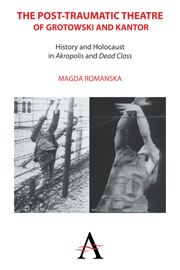 The Post-traumatic Theatre of Grotowski and Kantor
The Post-traumatic Theatre of Grotowski and Kantor from Part II - Our Memory: Kantor's Dead Class
Dead Class was received in Poland as a symbolic closing of contemporary art's neoavant-garde era. Many critics wondered at its subtle density of meanings, pointing out the self-contained nature of Kantor's work. Roman Szydłowski wrote: “There [was] not one empty space in this spectacle.” In a similar tone, in his essay “Signs and Significations in the Theatre of Tadeusz Kantor,” Olgierd Jędrzejczyk argued that every visual and aural element of Kantor's spectacle was embedded with a multiplicity of signs, each one as important as all the others:
Even the most vulgar gestures seem like an innocent child's play, in this pageant of our fears about our future, about passing the exam of life. In Kantor's theatre, every sign signifies, every gesture has meaning, every flicker of light is important. If you were to take away even one idea, there would be nothing left: everything is perfectly integrated. That is why Kantor and his troupe pay special attention to every, even the most minuscule, detail, even in the midst of what appears to be chaos. That's how they created a show that's like a poem in which great passions compete with lugubrious observations about the world.
Many critics noted that assigning all of the spectacle's elements – actors, props, music, set, text – equal footing creates a natural tension between them, with each element struggling to assert its dominance, or at least to reclaim a traditional sequence of meaning.
To save this book to your Kindle, first ensure no-reply@cambridge.org is added to your Approved Personal Document E-mail List under your Personal Document Settings on the Manage Your Content and Devices page of your Amazon account. Then enter the ‘name’ part of your Kindle email address below. Find out more about saving to your Kindle.
Note you can select to save to either the @free.kindle.com or @kindle.com variations. ‘@free.kindle.com’ emails are free but can only be saved to your device when it is connected to wi-fi. ‘@kindle.com’ emails can be delivered even when you are not connected to wi-fi, but note that service fees apply.
Find out more about the Kindle Personal Document Service.
To save content items to your account, please confirm that you agree to abide by our usage policies. If this is the first time you use this feature, you will be asked to authorise Cambridge Core to connect with your account. Find out more about saving content to Dropbox.
To save content items to your account, please confirm that you agree to abide by our usage policies. If this is the first time you use this feature, you will be asked to authorise Cambridge Core to connect with your account. Find out more about saving content to Google Drive.